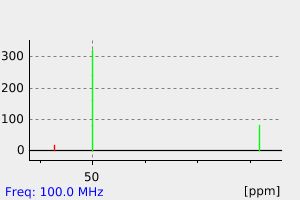1,1-二溴环丁烷 | 33742-81-3
中文名称
1,1-二溴环丁烷
中文别名
——
英文名称
1,1-dibromocyclobutane
英文别名
——
CAS
33742-81-3
化学式
C4H6Br2
mdl
——
分子量
213.9
InChiKey
OMVVCERCDNKSEN-UHFFFAOYSA-N
BEILSTEIN
——
EINECS
——
-
物化性质
-
计算性质
-
ADMET
-
安全信息
-
SDS
-
制备方法与用途
-
上下游信息
-
文献信息
-
表征谱图
-
同类化合物
-
相关功能分类
-
相关结构分类
物化性质
-
沸点:167.06°C (rough estimate)
-
密度:1.9300
计算性质
-
辛醇/水分配系数(LogP):2.6
-
重原子数:6
-
可旋转键数:0
-
环数:1.0
-
sp3杂化的碳原子比例:1.0
-
拓扑面积:0
-
氢给体数:0
-
氢受体数:0
安全信息
-
海关编码:2903890090
SDS
上下游信息
-
下游产品
中文名称 英文名称 CAS号 化学式 分子量 环丁基溴 Bromocyclobutane 4399-47-7 C4H7Br 135.004
反应信息
-
作为反应物:参考文献:名称:Kishner, Zhurnal Russkago Fiziko-Khimicheskago Obshchestva, 1907, vol. 39, p. 924摘要:DOI:
-
作为产物:描述:参考文献:名称:Blankenship, Craig; Paquette, Leo A., Synthetic Communications, 1984, vol. 14, # 11, p. 983 - 988摘要:DOI:
文献信息
-
A Novel Route to Geminal Dibromocyclobutanes: Syntheses of 2-Substituted Cyclobutanone Acetals and Their Reaction with Boron Tribromide作者:Tore Nordvik、Udo H. BrinkerDOI:10.1021/jo035295o日期:2003.11.1Nine 2-substituted cyclobutanone acetals, in addition to the parent cyclobutanone acetal, were synthesized from their corresponding cyclobutanones and subsequently treated with boron tribromide. The substituents were either alkyl chains or a phenyl and a benzyl group, respectively. The major compounds obtained in these reactions were, in most cases, the geminal dibromocyclobutanes which were obtained
-
Cyclobutylidenes from geminal dihalogenocyclobutanes作者:Udo H. Brinker、Gilbert SchenkerDOI:10.1039/c39820000679日期:——Cyclobutylidene, or a related carbenoid, can be generated by reaction of geminal dibromocyclobutane with methyl-lithium at temperatures as low as –78 °C to yield methylanecyclopropane and cyclobutene nearly quantitatively.
-
Discovery of highly potent human glutaminyl cyclase (QC) inhibitors as anti-Alzheimer's agents by the combination of pharmacophore-based and structure-based design作者:Nguyen Van Manh、Van-Hai Hoang、Van T.H. Ngo、Jihyae Ann、Tae-ho Jang、Jung-Hye Ha、Jae Young Song、Hee-Jin Ha、Hee Kim、Young-Ho Kim、Jiyoun Lee、Jeewoo LeeDOI:10.1016/j.ejmech.2021.113819日期:2021.12tested compounds, the cyclopentylmethyl derivative (214) exhibited the most potent in vitro activity (IC50 = 0.1 nM), while benzimidazole (227) showed the most promising in vivo efficacy, selectivity and druggable profile. 227 significantly reduced the concentration of pyroform Aβ and total Aβ in the brain of an AD animal model and improved the alternation behavior of mice during Y-maze tests. The crystal谷氨酰胺酰环化酶 (QC) 的抑制可能通过减少AD 患者大脑中有毒的 β-淀粉样蛋白 (Aβ N3pE )的量来为治疗早期阿尔茨海默病 (AD) 提供有希望的策略。在这项工作中,我们确定了有效的 QC 抑制剂,其 IC 50值比 PQ912 高出 290 倍,而 PQ912 目前正在 II 期临床试验中进行测试。 在测试的化合物中,环戊基甲基衍生物 ( 214 ) 表现出最有效的体外活性 (IC 50 = 0.1 nM),而苯并咪唑 ( 227 ) 表现出最有希望的体内功效、选择性和成药特性。227显着降低了AD动物模型大脑中pyroform Aβ和总Aβ的浓度,并改善了小鼠在Y迷宫测试中的交替行为。与214复合的人 QC ( h QC)的晶体结构表明在活性位点紧密结合,支持 QC 的特异性抑制导致有效的体外和体内活性。考虑到靶向 Aβ 的 donanemab 最近的临床成功N3pE,基于小分子的
-
A New Rotane Family: Synthesis, Structure, Conformation, and Dynamics of [3.4]-, [4.4]-, [5.4]-, and [6.4]Rotane<sup>1</sup>作者:Lutz Fitjer、Christoph Steeneck、Said Gaini-Rahimi、Ulrike Schröder、Karl Justus、Peter Puder、Martin Dittmer、Carla Hassler、Jörg Weiser、Mathias Noltemeyer、Markus TeichertDOI:10.1021/ja973118x日期:1998.1.1The synthesis, structure, conformation, and dynamics of a new rotane family consisting of four-membered rings are described. All syntheses are based on bicyclobutylidene (9): [2+1] cycloaddition of cyclobutylidene yields [3.4]rotane (5) (9−5), [2+2] cycloaddition of trimethyleneketene followed by spiroalkylation of the resulting trispiroketone 10 yields [4.4]rotane (6) (9−10−13−14−6), homologization描述了由四元环组成的新 rotane 家族的合成、结构、构象和动力学。所有合成均基于双环丁叉 (9):环丁叉的 [2+1] 环加成生成 [3.4] 轮烷 (5) (9-5),三亚甲基乙烯酮的 [2+2] 环加成,然后将所得三螺酮 10 进行螺烷基化,生成 [3.4] 4.4]rotane (6) (9-10-13-14-6), 10 通过 β-羟基硒化物的同源化可以得到四螺环酮 11 和五螺环酮 12 (10-15-11-16-12), 并进一步详细说明向环丙基卡宾-环丁烯重排产生 [5.4] 轮烷 (7) 和 [6.4] 轮烷 (8) [11(12)-18(24)-19(25)-20(26)-21(27)-22( 28)-23(29)-7(8)]。6, 7, 的结构 和 8 是通过高精度低温 X 射线分析和力场计算确定的,使用搜索程序 HUNTER 与 MM3(92) 相关联。观察到以下特征:从
-
Kishner, Zhurnal Russkago Fiziko-Khimicheskago Obshchestva, 1905, vol. 37, p. 103作者:KishnerDOI:——日期:——
表征谱图
-
氢谱1HNMR
-
质谱MS
-
碳谱13CNMR
-
红外IR
-
拉曼Raman
-
峰位数据
-
峰位匹配
-
表征信息
同类化合物
(3-溴-1-丙炔-1-基)环丙烷
马杜拉霉素
顺-3,顺-6-1-溴壬二烯
顺,反,顺-1,2,3,4-四(2-溴乙基)环丁烷
金刚烷-2,2-d2
辛烷,1,5-二溴-
苯并噻唑,6-异硫氰酸根合5-甲基-(9CI)
苯(甲)醛,3-甲氧基-4-硝基-
硬脂基溴
硫杂二溴化
癸基溴
甲基环丙基溴化镁
环戊醇1-乙基-3-(苯甲基)-(9CI)
环戊烯-1,3-溴-(7CI,9CI)
环丙烷,1-溴-1-(3,3-二甲基-1-丁炔基)-2,2-二甲基-
环丁基溴
溴甲基环戊烷
溴甲基环己烷
溴甲基环丙烷
溴甲基环丁烷
溴甲基
溴环戊烷-D9
溴己烷-D3
溴己烷
溴化环辛基甲基
溴代环辛烷
溴代环戊烷
溴代环庚烷
溴代环丙烷
溴代异辛烷
溴代异丁烷
溴代叔丁烷-D9
溴代叔丁烷
溴代十四烷-D29
溴代十四烷
溴代十六烷-D33
溴代十六烷
溴代十五烷
溴代十二烷
溴代二十烷
溴乙醛
溴乙烷-D3
溴乙烷-D1
溴乙烷-2-13C
溴乙烷-13C2
溴乙烷-1-13C
溴乙烷-1,1-d2
溴乙烷-1,1,2,2-d4
溴乙烷
溴丙烷-D4







